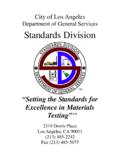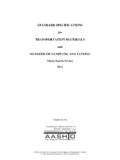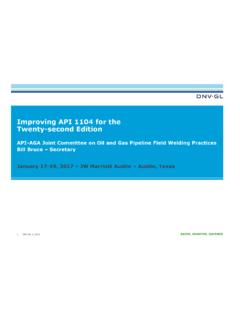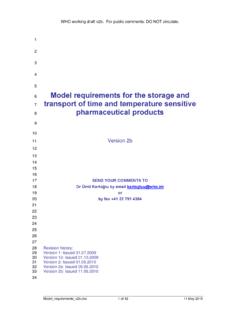Transcription of British Columbia Cancer Agency POLICY Title: Hazardous ...
1 British Columbia Cancer Agency POLICY Title: Hazardous drug safe handling standards Number: V-10 Effective Date: September 1, 1997 Revised August 1, 2000, November 2012, December 2013 August 2014 Approved By: Provincial Systemic Program Committee Page 1 of 12 A. SCOPE This POLICY covers the preparation, administration, and disposal of Hazardous drugs. See Cancer drug Manual Appendix 5 for the Hazardous drug List. ( ) Hazardous drugs may have also been referred to as cytotoxics, antineoplastics or chemotherapy. These drugs may be administered by many routes. This POLICY refers to all routes of administration. A drug containing a living organism with the potential to cause infections in humans will be considered a Hazardous drug with the designation of biohazardous drug , and will be included on the BCCA HD List.
2 For further information, refer to the individual drug monographs in the BCCA Cancer drug Manual and relevant site and departmental directives and procedures. B. POLICY STATEMENT The management of the British Columbia Cancer Agency is committed to promoting a safe and healthy workplace for all staff in the organization. Hazardous drugs must be properly handled, in accordance with this POLICY and attached tables, to ensure that the receipt, storage, preparation, administration, and disposal of these agents will not pose an undue hazard to the staff or patients involved in their use. C. RESPONSIBILITIES Senior Management Designate responsibility for the implementation and maintenance of the Hazardous drug safe handling standards .
3 Ensure that all managers and supervisory staff are familiar with and adhere to the Hazardous drug safe handling standards . Ensure that health surveillance mechanisms are established for all staff that are at significant risk of exposure to Hazardous drugs. Directors/Managers and Supervisory Staff Ensure that all staff are fully familiar with the Hazardous drug safe handling standards and that they receive safe handling education and training. Ensure that staff comply with all workplace safe handling policies and procedures. Ensure that the health and safety of patients and staff are given primary consideration when implementing or altering processes, programs, or physical facilities related to Hazardous drugs.
4 Make every effort to accommodate requests to change work assignments for staff who are pregnant, breastfeeding or attempting to reproduce. British Columbia Cancer Agency POLICY Title: Hazardous drug safe handling standards Number: V-10 Effective Date: September 1, 1997 Revised August 1, 2000, November 2012, December 2013 August 2014 Approved By: Provincial Systemic Program Committee Page 2 of 12 Ensure Hazardous drug exposure records are maintained for duration of employment of each employee plus 10 years, and training records for 3 years from the date training occurred. (WorkSafe BC Regulations). Healthcare Staff Follow all safety requirements according to WorkSafe BC Cytotoxic Regulations and the Hazardous drug safe handling standards and BCCA policies/directives.
5 Report all unsafe acts and conditions. Actively participate in the recommended health surveillance programs. Actively participate in the education and training programs provided. Workplace Health (PHSA) Co-ordinate the planning, development, and implementation of a comprehensive Exposure Control Plan Develop, implement, and maintain a health surveillance program for all staff exposed to Hazardous drugs. Assist in the development of new procedures as required. D. GENERAL DIRECTIVES Staff Education Education for the safe handling and exposure documentation of Hazardous drugs is to be provided prior to working with Hazardous drugs,. Information on the possible risks and necessary precautions to take when handling Hazardous drugs must be made available to all relevant staff.
6 Written procedures for handling Hazardous drugs must be accessible to all relevant staff. Personnel handling Hazardous drugs must receive education and training in the use of personal protective equipment, safe handling procedures and Hazardous drug spill management to decrease risk of exposure to these agents. (Refer to Table 2) To ensure that safe handling procedures are being followed, work practices must be assessed at appropriate intervals with retraining provided as necessary. Storage and Transportation Access to Hazardous drug storage areas must be limited to authorized personnel. Primary containers of prepared Hazardous drugs must be transported in, sealed, zip-lock bags and stored in these bags until time of administration.
7 British Columbia Cancer Agency POLICY Title: Hazardous drug safe handling standards Number: V-10 Effective Date: September 1, 1997 Revised August 1, 2000, November 2012, December 2013 August 2014 Approved By: Provincial Systemic Program Committee Page 3 of 12 Hazardous drugs must be stored separately from other drugs. Storage bins/shelves must be designed in a manner that will contain accidental leakage and reduce the chance of Hazardous drugs falling to the floor. Pneumatic tubes must not be used for transporting Hazardous drugs. Damaged cartons containing Hazardous drugs are NOT opened. They must be isolated and handled following BCCA POLICY V-30, Hazardous drug Spill Management (section II) and/or relevant directives (Refer to Table 1).
8 For transportation outside the facility, Hazardous drugs must be wrapped to avoid breakage and packaged according to Transportation of Dangerous Goods Regulations. Hazardous drugs may be transported via courier or mail (oral Hazardous drugs) as per applicable BCCA pharmacy directives. (Refer to Table 1) Labelling/Signage To indicate their potentially Hazardous contents, Hazardous drugs (including oral and topical forms), wastes, equipment and waste containers must be labelled with distinctive warning signs/labels such as: " Hazardous - -- handle with gloves -- -- dispose of properly --" Warning signs must be posted in all areas where Hazardous drugs are stored or prepared.
9 The signs must be clearly visible and must clearly state the identified hazards. "CAUTION KNOWN OR SUSPECTED CARCINOGEN AUTHORIZED PERSONNEL ONLY" British Columbia Cancer Agency POLICY Title: Hazardous drug safe handling standards Number: V-10 Effective Date: September 1, 1997 Revised August 1, 2000, November 2012, December 2013 August 2014 Approved By: Provincial Systemic Program Committee Page 4 of 12 Personal Protective Equipment (PPE) Personal protective equipment (PPE) must be worn whenever Hazardous drugs are handled (Refer to Table 2). The appropriate PPE must be available in all areas where Hazardous drugs are handled (received, stored, prepared, administered and disposed).
10 PPE must be worn when disconnecting and disposing of equipment used in the administration of Hazardous drugs Gloves must be changed every 30 minutes or immediately if contaminated, torn, or punctured. Gowns must be changed daily or immediately if contaminated, and after Hazardous drug spill clean up. PPE must not be worn outside the Hazardous drug storage, preparation or administration areas. Used disposable PPE must be discarded as Hazardous waste. Wash hands with soap and water immediately after removal of gloves. drug Preparation BCCA personnel preparing Hazardous drugs will follow BCCA Pharmacy Practice standards for Hazardous Drugs and relevant BCCA Pharmacy directives.














